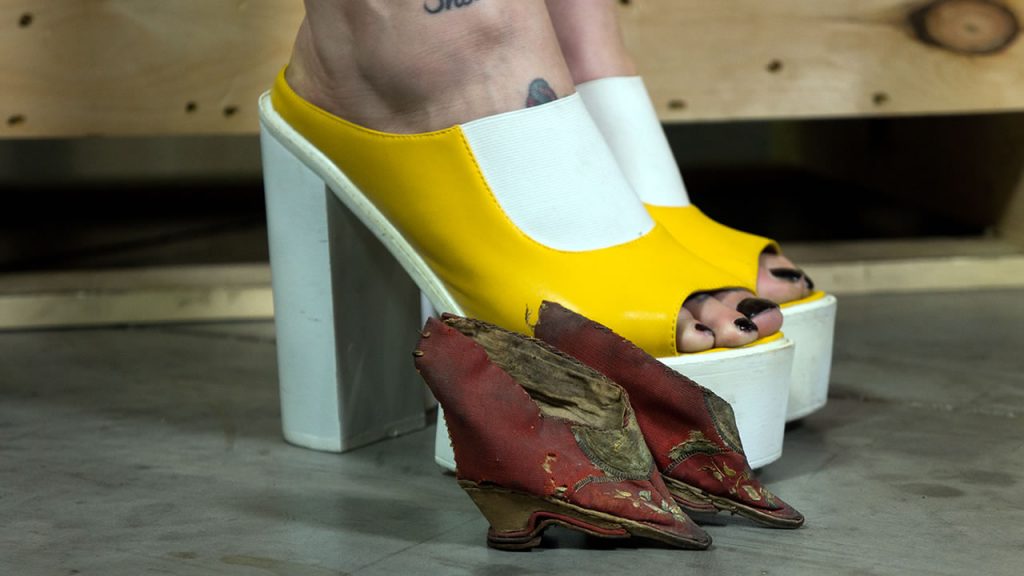Winner of the Fall 2016 StMU History Media Award for
Best Use of Scholarship
Best Article in the Category of “World History”
Best Use of Primary Sources
When I knew I couldn’t suffer another moment of pain and tears fell on my bloody bindings, my mother spoke softly into my ear, encouraging me to go one more hour, one more day, one more week, reminding me of the rewards I would have if I carried on a little longer. In this way, she taught me how to endure—not just the physical trials of footbinding or childbearing, but the more torturous pain of the heart, mind, and soul.1
More often than necessary, women are consumed with the idea of infatuation. Every culture has its own form of standards that pertain to women and what constitutes beauty. Although the world is slightly more accepting now, women used to go to extreme lengths to achieve an image that would be deemed attractive. In the Chinese culture, foot binding was that well-known beauty expectation for centuries. What started off as a celebrity fad, turned into a way of determining social status and eventually an all-around beauty expectation. 2 The objective of foot binding was for women to have the smallest foot possible, starting at very young ages. Not only was this a painful process for girls as young as five years, but it also promoted the idea that women must mutilate their bodies to become appealing to men. At some point in time, women began to just accept that this was something that was supposed to be done in order to be attractive. Often referred to as “lotus boats” or “golden lotuses,” bound feet started as a fad for the famous, and slowly made its way to becoming the social norm.3

This practice began around the tenth century with women in the entertainment business. These women were adored for their tiny arched feet and were seen by men to be much more attractive than middle class women with average feet. As these dancers were gaining an audience, the idea of “lotus feet” was becoming familiar. Not long after these performers expressed their “beauty,” foot binding became a norm for women who wanted to fit in and even for those who had a desire to find a husband.4 This painful process consisted of the breaking of young girl’s toes to form the desired triangular shape. Then the arch of the foot would be bent horizontally from the toes all the way to the heel. As if this was not painful enough, the girls were forced to walk on their feet to intensify the arch, breaking the foot even more. After all of this, the foot would be wrapped to maintain the shape of it as well as prevent any sort of deviation.5

Although this practice was around for centuries, it was only a matter of time before someone realized how inhumane and cruel it really was. Thankfully, many people began to protest against foot binding, forming “anti-foot binding organizations” to raise awareness on the inhumanity of binding women’s feet. By the 1950’s, laws were passed, allowing women to unbind their feet. Although hesitant at first, the trend slowly declined. Many women protested to unbinding their feet, due to the fact that it had been a social norm a thousand years. However, the movement against foot binding continued and eventually the last of the factories that make the tiny shoes were shut down, disabling the women from continuing the custom. Today, foot binding is no longer practiced and the only women who continue to maintain the tiny feet are those elder women who refuse to let go of the past.6
- Lisa See, Snow Flower and the Secret Fan (New York: Random House Publishers, 2005), 3-4. ↵
- Yaodong Gu et al., “Foot Loading Characteristics of Chinese Bound Feet Women: A Comparative Analysis,” PLoS ONE 10, no. 4 (April 2015): 1–9, doi:10.1371/journal.pone.0121695. ↵
- Yu-ning Li, Chinese Women Through Chinese Eyes (New York: Routledge, 2015), 125-127. ↵
- Women in the Middle Ages: An Encyclopedia, 2004, s.v. “Footbinding (Late 10th Century-early 20th Century),” by Patricia Buckley Ebrey. ↵
- Amanda Foreman, “Why Footbinding Persisted in China for a Millennium,” Smithsonian, accessed November 8, 2016, http://www.smithsonianmag.com/history/why-footbinding-persisted-china-millennium-180953971/. ↵
- “Women with Bound Feet in China,” Reshaping the Body: Clothing & Cultural Practice, accessed November 8, 2016, http://exhibits.hsl.virginia.edu/clothes/lady_bound/. ↵



189 comments
Brianda Gomez
This article is a great example of the huge impact that culture had on many Chinese women and how they wanted to be seen in their country. To me, it is crazy, that women would go to the extent and practice, “foot binding” to appear more attractive and become adored by men. This was a very dangerous practice because it broke the foot and cause and endless amount of pain. I really enjoyed this article. Great job!
Richard Navarro
I could only imagine the pain that these women went through. Chinese foot binding had been around for centuries. “Beauty is pain” was really these women’s motto during this time. I can not even begin to understand how men saw this as “attractive”. I saw an episode on Taboo about Chinese foot binding, and I couldn’t bring myself to understand this custom. I am glad that this has come to be non-existent.
Briana Myers
I have read other articles and stories that were based on this custom of foot binding and I always thought that it is very disappointing how people are willing to do such horrific things in order to fit into the trends of society. This is something that was very painful for these women yet they felt like they had to do it because that is what society told them had to be done in order to be beautiful and attractive.
Belene Cuellar
I can’t believe this kind of practice was allowed to go on all this time. All of those women and little girls mutilating themselves just to achieve a form of society’s standards. I’m glad the author wrote this article to shine light on the horrible conditions women had to go through to be declared beautiful by men. It was clear and to the point, the images provided in the article also made me feel anger and remorse for those women that had to disfigure themselves.
Evelin Joseph
This article was beautifully written and expressed something that is truly important in the world today. Girls everywhere are held to unattainable expectations, and that definitely hurts. Practices like foot binding bring to light the true detrimental effects of such expectations and the need to stop such atrocious practices. It was depressing to know that these women went through immense pain, from breaking their feet to even later walking on it, to simply fit into society and its standards. I’m glad that this practice was ended and I hope that more like this will be stopped in the future as well.
Veronica Spryszynski
While reading I thought that the binding of the feet was just to wrap the foot at a young age and never unwrap it until it was very small that it couldn’t grow anymore, more when I read that the toes had to be broken to a triangle and the arch of the foot put horizontally my stomach dropped…great detail used in that to give the reader that feeling! Thankfully those customs are not practiced anymore if must be really painful for young women. I don’t see how that was a beauty trend because it deformed the poor feet of the females.
Mariet Loredo
Great article! What really caught my eye and made me continue reading this was the quote at the beginning of the article. It’s interesting knowing that every culture has its beauty standards.I remember watching a documentary in high school about foot binding. I find it very odd how women will break there feet just make themselves more attractive. It’s a good thing that the norms have changed and women don’t have to go through that type of pain anymore.
Maria Callejas
First of all, great introduction! You give a factful insight to what you will discuss in the following paragraphs, so perfect preview. It is indeed impressive the limits people will push to attain “beauty”. I did know about foot bending, however, I didn’t know the depths of it. It was necessary for justice/law to step in, this was truly an atrocious act. It is easy to translate this to our modern world, people will plastic surgery, completely transforming their looks, to be “beautiful”. Great usage of sources, you really did write an awesome article!
Samuel Stallcup
Neat article. I learned about this practice in high school and it made me a little bit uncomfortable because of how gross it looked. However I was unaware of the history of this becoming a trend in Chinese women culture. It’s quite interesting that famous people had enough influence to cause this to become a trend among the common people.
Erin Vento
Topics like this make you think of some of the pressures girls feel to look appealing. You did a great job at describing the process of footbinding and its origin. It’s weird to think that seeing young girls breaking their feet to make them look triangles was almost as common as seeing a girl wear makeup- however unlike wearing makeup, people ignored the fact that footbinding caused the girl’s pain. The pictures you put were really powerful as well!